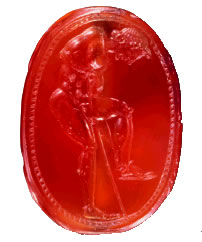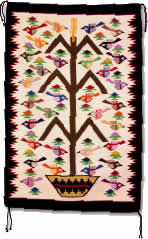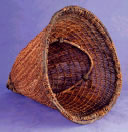From
the collection of the J. Paul Getty Museum

Butterfly
basket, San Juan Southern Paiute, Grace Lehi, 1980s

Engraved
Scarab, Epimenes, about 500 B.C.

Statue
of a Victorious Youth,
artist unknown, 300-100 B.C.

Attic Red-Figure Kylix, attributed to Carpenter Painter,
515-510 B.C.
Utah Museum of Natural History
Of particular interest in the lineup is Utah’s First Nations: Peoples of the Great Basin and Colorado Plateau, opening Jan. 18 and continuing through Sept. 29, 2002, in the Utah Museum of Natural History’s Dumke Gallery. The idea for the exhibit came from the museum’s Indian Advisory Committee, organized more than 15 years ago, and marks a remarkable collaboration among Utah’s tribes and the museum. (details below)
The exhibit will include artifacts from the Northern Ute, Northwestern Shoshoni,
Confederated Tribes of Goshute, Skull Valley Band of Goshute, Navajo, Southern Paiute, and White Mesa Ute, providing a unique opportunity for visitors to learn about the indigenous peoples of this region.
Guest curator Nola Lodge, a member of the Oneida Tribe of the Iroquois Confederation tribe, and exhibit developer Becky Menlove asked each tribe to identify a defining moment—a turning point—in its history and to tell that story through the exhibit.
“The Northwestern Shoshoni are going to focus on the lifestyle of their people after the Bear River massacre,” says Lodge. “The Navajos want to focus on family and clan, and how important it is to their survival. And the Utes want to tell about the importance of the horse to their culture,” she adds.
Lodge and Menlove traveled to each reservation on several different occasions to see what kinds of artifacts were available. “They are willing to loan us their family heirlooms,” says Lodge. “This will be the first time some of this has ever been on public display.”
Lodge laments the fact that so often the American—and international—public has a stereotypical image of what an American Indian is. She says it grows out of the romantic Plains Indian image of the mounted horseman with headdress found so often in books and movies. “There is no understanding that there is no one American Indian, ” says Lodge. “We are all unique groups with a unique cultural history, material culture, and experience. And our experiences differ from place to place.” Lodge hopes this exhibit will help to dissolve this stereotype.

Northwestern
Shoshoni doll,
Lucy Honevah, 1910

Attic
Black-Figure Nicosthenic| Amphora, attributed to Painter N, about 520
B.C.

Tree of life rug, Navajo, Mae Bow, 1985

Goshute
burden basket, maker unknown,early 1900s

Black-Figure Volute Krater, attributed to the Leagros Group, 510-500 B.C.
